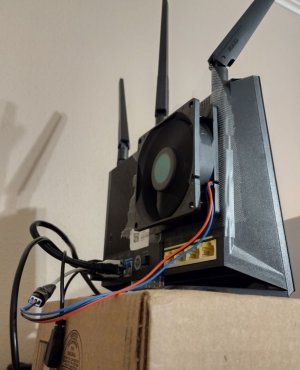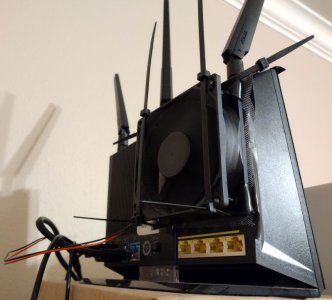Sadly, the prior thread just expired - 6 months inactivity limit ...

 www.snbforums.com
www.snbforums.com
This is a great post - even if I am late to the party!
I thought at first to stick a copper shim on the cpu in AC86u, but let's face it - it's not the cpu that fails in your examples, it's a lot of other stuff too. So what good is fixing the cpu, when something else would fail? Also, procuring the shim of the right thickness is a bit of a pain in the neck.
So I basically added a single fan on the side of the cpu as to dissipate that particular hot spot. Radios temps dropped too, but a lot less, since the fan is on the other side. Here is my fan becoming operational, 1st temp cpu, 2nd - 2.4, 3rd - 5. Overall, about 18 C drop in cpu temps, and 5 C drop in the radio temps.
I taped small 6mm magnets into the cpu fan holes with the tape on both sides of the holes (drilled out the holes a bit). On the router side I taped small steel washers to the router with electrical tape. The fan is attached via magnets. The 12V cpu fan runs at 5V, the current appears to be 10 mA yielding 50 mW of power consumption out of USB3 port. I also stuck a sheet of tulle fabric between the fan and the router for dust control. The fan is pushing air into the side of the router as per original design, with the air exhaust on top.
Yearly electricity consumption is 0.05W*24*365=438W/h ~ $0.06 . Definitely worthwhile insurance!
Update: added pictures of my cooling setup, with zip-ties to make the solution more robust! Fan was replaced too for a more quiet model. The original magnet/electric tape attachement kept falling off after a few weeks due to the tape coming off the fan corners. But zip ties came to rescue, and there is an additional zip tie looping over the top antennas.

Router temperatures
Hello everybody With this release, temperature of my RT-AC86U has risen again. It's around 96°c. and logs shows CPU turned off due to excessive heating. CPU Wait is ENABLED. Anyone else experiencing this? Thanks
...
A few resurrected RT-AC86U routers are sitting on my shelf. Those fail in big numbers. Asus is reusing parts from previous models and they don't fit properly. Some of you may have noticed a number of huge thermal transfer pads. The gaps between the ICs and the heatsink are as large as 3mm. It's built as cheap as possible with hope for the best. There are many thermal stress points on this PCB. It lights up like NYC night lights on the thermal camera image. Lead free solder doesn't like thermal stress points. VRMs fail as well as RF ICs. I had to replace few VRMs and reflow a RF IC to bring a few back to life. The repair is not worth it. Fix one thing and something else fails. The bad design always wins. Using copper shims and thermal paste drops the temperatures you report by 20C. A fan on top drops it further another 20C. My general recommendation is to avoid this model. If you already have it avoid on/off cycles to reduce the thermal stress. A fan is a workaround temporary solution. When the VRMs fail you get one LAN port light lit or some other LED half lit. When the RF IC fails you get Channel 0 in your UI. I don't know why Asus uses 19V PS and then drops the voltages down with multiple VRMs. It only creates more failure points and generates more heat. Other routers do fine with 6-12V PS. I can't find schematics online for Asus routers. Looking at the components used nothing needs 19V. Good luck to RT-AC86U owners.
This is a great post - even if I am late to the party!
I thought at first to stick a copper shim on the cpu in AC86u, but let's face it - it's not the cpu that fails in your examples, it's a lot of other stuff too. So what good is fixing the cpu, when something else would fail? Also, procuring the shim of the right thickness is a bit of a pain in the neck.
So I basically added a single fan on the side of the cpu as to dissipate that particular hot spot. Radios temps dropped too, but a lot less, since the fan is on the other side. Here is my fan becoming operational, 1st temp cpu, 2nd - 2.4, 3rd - 5. Overall, about 18 C drop in cpu temps, and 5 C drop in the radio temps.
Code:
Sep 25 08:15:00 RT-AC86U-9988 Temp: 70.4 46.0 54.0 ; Mem free: 27984 KB; Swap used: 28772 KB
Sep 25 08:30:00 RT-AC86U-9988 Temp: 70.4 46.0 54.0 ; Mem free: 33716 KB; Swap used: 28772 KB
Sep 25 08:45:00 RT-AC86U-9988 Temp: 70.9 46.5 54.0 ; Mem free: 32116 KB; Swap used: 28772 KB
Sep 25 09:00:00 RT-AC86U-9988 Temp: 71.4 46.5 54.0 ; Mem free: 27592 KB; Swap used: 28772 KB
Sep 25 09:15:00 RT-AC86U-9988 Temp: 55.2 41.5 50.0 ; Mem free: 30244 KB; Swap used: 29684 KB
Sep 25 09:30:00 RT-AC86U-9988 Temp: 51.8 40.0 49.0 ; Mem free: 32772 KB; Swap used: 29716 KB
Sep 25 09:45:00 RT-AC86U-9988 Temp: 51.3 40.0 49.0 ; Mem free: 32080 KB; Swap used: 29716 KB
Sep 25 10:00:00 RT-AC86U-9988 Temp: 51.8 40.0 49.0 ; Mem free: 27688 KB; Swap used: 29716 KBI taped small 6mm magnets into the cpu fan holes with the tape on both sides of the holes (drilled out the holes a bit). On the router side I taped small steel washers to the router with electrical tape. The fan is attached via magnets. The 12V cpu fan runs at 5V, the current appears to be 10 mA yielding 50 mW of power consumption out of USB3 port. I also stuck a sheet of tulle fabric between the fan and the router for dust control. The fan is pushing air into the side of the router as per original design, with the air exhaust on top.
Yearly electricity consumption is 0.05W*24*365=438W/h ~ $0.06 . Definitely worthwhile insurance!
Update: added pictures of my cooling setup, with zip-ties to make the solution more robust! Fan was replaced too for a more quiet model. The original magnet/electric tape attachement kept falling off after a few weeks due to the tape coming off the fan corners. But zip ties came to rescue, and there is an additional zip tie looping over the top antennas.
Attachments
Last edited:






